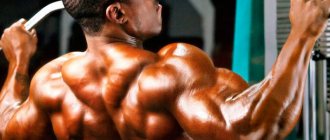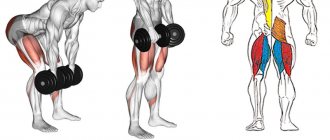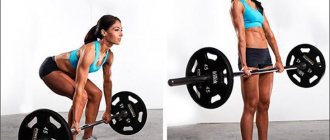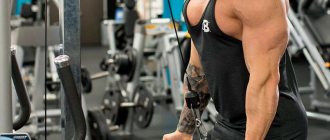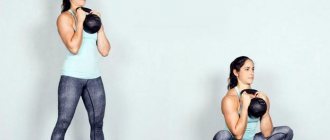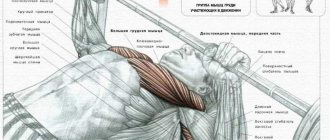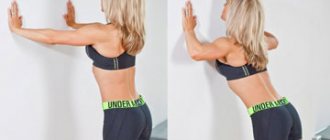execution technique, difference from Romanian and classical
Deadlifts are included in all lists of exercises for strength training with weights, but not everyone can master it right away. Just a few nuances that an athlete forgets about can negate all the results of a hard workout. This material contains all the most important things about deadlifts on straight legs.
General concepts
One of the main basic competitive exercises in powerlifting is the deadlift or Dead Lift, which allows you to gain muscle mass in the lower back, hamstrings, and buttocks. It also uses several joint groups at once, so the knee joint does not experience the same load as when performing squats or lunges.
One of the advantages of deadlifts is that they form the muscles of the buttocks well, contouring the thigh muscles from them.
What muscles are involved?
In fitness, the stiff leg deadlift is a type of isolated exercise, but this does not mean that it develops only one muscle group.
The following muscle groups are involved in the work:
- The buttocks, thigh muscles, adductor muscles of the legs, as well as the trapezius, rhomboid and latissimus dorsi muscles.
- The calf and calf muscles are used together.
- The press stabilizes the position of the body.
- The muscles of the hands and forearms that support weight.
- Muscles of the cervical region, since the exercise must be performed with the head raised.
Thus, by including deadlifts in training, an athlete can increase the strength of several muscle groups at the same time, build muscle mass and achieve a sculpted silhouette of the entire body.
In addition to muscle development, deadlifts successfully train the hamstring ligaments, developing their flexibility. Further, strong and flexible tendons allow the athlete to push more weight without risking injury. Strengthening muscles and ligaments also delays the possibility of developing age-related musculoskeletal diseases.
Correct execution is important
To get the expected result, you must follow the following rules:
- The exercise should be performed slowly, moving evenly and smoothly. Deadlifts will not be effective if you work in jerks. Moreover, jerking can lead to injury.
- Despite the name “stiff-legged deadlift,” it should be performed with your knees slightly bent. The degree of leg flexion depends mainly on the stretch of the athlete. More flexible people can straighten their knees almost completely; less flexible people should avoid this. But during the exercise, the knee joints should not move, they remain fixed.
- Performing deadlifts with a barbell puts stress on the back muscles. To ensure maximum load on the biceps of the thighs and buttocks, it should be carried along the legs.
- The exercise can be done using both grips - forward or reverse. And, to increase the load, you can use the so-called mixed grip, when one hand grabs the bar with a direct grip, and the other with a reverse grip.
- Deadlifts are usually performed with a barbell, but the version with dumbbells is no worse if you keep both dumbbells side by side and do not forget about this while performing sets. Working with dumbbells provides one important advantage - the arms are in a natural, somewhat extended position, which prevents new injuries and makes training easier for those who have already had these injuries in the past.
- Some trainers advise during the exercise to step with the toes of the feet on a height of 2-3 cm. This position of the athlete’s legs puts maximum load on the hamstrings and gluteal muscles.
- While bending, your back should be kept straight, your shoulder blades retracted, and your head raised. When bending and straightening, the athlete should not spread his shoulder blades, round his back or lower his head. One of the best ways to maintain the desired position is to choose a point in front and look at it as you perform. Then the back will not round, and the exercise will be beneficial.
- Experts argue whether it is worth straightening up completely while performing a deadlift. Everyone can decide this question for themselves if they take into account that when the muscles are fully straightened, they rest for a few seconds. By keeping the body in a slightly bent position, the athlete does not allow himself to relax, achieving the maximum training effect. Therefore, coaches do not advise athletes with a sufficient level of training to do this.
- The load on the gluteal muscles can be controlled by moving or spreading your legs wider. The closer your feet are to each other, the more tense your buttock muscles will be. But you should not move your legs completely - this is too unstable a position for lifting large loads.
Proper execution of the exercise and an individual approach to weight selection prevents injury.
Denis Borisov will tell you everything about the rules of execution and the nuances that you need to pay attention to when performing the exercise in the video blog.
Contraindications
Deadlifts on straight legs should not be performed by people who have:
- back injuries;
- damage to the popliteal ligaments;
- injuries in the area of the hands.
Performance
Warm up your muscles with preliminary exercises. Among them, do not forget to bend on straight legs, touching your toes to the floor.
Sequential steps when performing:
- Prepare a suitable load - a barbell or dumbbells.
- Support the weight in a way that is comfortable for you.
- Stand straight with your feet shoulder-width apart or slightly closer.
- Bend your knees slightly and hold this stance.
- Straighten your shoulders so that your shoulder blades are retracted and raise your head.
- As you inhale, lower the dumbbells or barbell along your legs, moving your pelvis back just a little.
- Lower the load to the middle of the shin, and if stretching allows, a little lower. Hold this position. Feel the muscle tension.
- As you exhale, return to the starting position, continuing to keep your knees slightly bent, “soft.”
- The number of executions should be determined by a professional trainer based on the physical fitness of the trainee.
Why it is more convenient to work with dumbbells and how to properly perform deadlifts on straight legs - Yaroslav Brin shares his experience in a video clip.
What is the difference from Romanian and classical?
The main difference between a deadlift and a Romanian deadlift is how the hip joint moves during the tilt. In the Romanian deadlift, the gluteal area is maximally involved, the pelvis is retracted back. In fact, the deadlift is a workout for the back muscles and a little for the biceps of the legs, and the Romanian is an exercise for the buttocks and a little for the back.
The classic deadlift is much more different from the deadlift. The classic deadlift includes two components - squatting and straightening. When performing a classic deadlift, the trainee lowers the barbell and squats, and in a deadlift, the legs remain relatively straight throughout the entire exercise.
Performing stiff-legged deadlifts may not be the easiest thing in fitness, but if you master it correctly, the results will not be long in coming. The deadlift is an exercise that should be loved by those who want to strengthen the muscles of the buttocks, back of the legs, lower back and leg ligaments, and achieve a beautiful athletic figure in general.
Create your personal training program:
krasota-zdorove.com
Execution Rules
The Romanian deadlift must be performed with complete focus on the process, and take into account some of the features that make the Romanian lifts have the greatest effect:
- The body straightens due to the tension of the muscles being worked, and not due to the back muscles.
- Under no circumstances should you rush and rise and fall in jerks. This may cause injury.
- This exercise should be started with a light weight, trying to master the lifting technique as much as possible. Then you can take on more weight.
- You should definitely feel every muscle that is under stress. If there is no tension in the muscles for which the exercise is performed, then the exercise is performed incorrectly.
- You need to talk to your coach about the number of repetitions.
- When starting to perform the Romanian lift, stand next to a mirror and watch your technique.
- Perform the exercise every other day and not more often. This way, you will avoid overload, and the muscles will have time to recover after the load.
- Girls can adopt this principle: the closer you place your legs, the more load you can focus on the buttocks.
Difference between deadlift and Romanian deadlift. Romanian deadlift. The most complete guide.
In strength sports, to strengthen the muscles of the buttocks and thighs, there is an exercise called the Romanian deadlift. It is named after the athlete Vlad Nicu from Romania. He often used this exercise in his training. It has several differences from the classic version. You will learn more about the execution technique below.
What is Romanian deadlift
This physical exercise is popular among both men and women. Romanian deadlift is a downward bend with an apparatus in your hands - a barbell or dumbbells - completely on straight legs or with bent knees. At the same time, a natural deflection must remain in the lower back, otherwise the risk of injury significantly increases. The back muscles are also protected due to the fact that the arms are lowered only to the middle of the shins. Unlike the classical technique, where the back is also worked out, the dead one helps to pump each thigh (its biceps) and buttocks, it does not put additional strain on the spine.
Technique for performing the Romanian deadlift
The concept of “dead” is applied to such an exercise for a reason. It's all about translation from English. "Dead" sounds like "dead". The exercise itself is called “dead-lift”. This is a dead option. The most difficult type is on one leg. In addition to it, the press also begins to work, which acts as a stabilizer. The technique here is little different. The only difference is that when lowering, the non-working leg is pulled back.
The optimal way is to deadlift the barbell with straight legs. This makes it more convenient to control movement and keep the limbs at the same distance. Another option is stiff-legged deadlifts with dumbbells:
- It is less popular, because muscle tension here is not symmetrical.
- It is important to exclude even minimal deviations of projectiles. Only in this way will the technique of performing the Romanian deadlift be correct and ensure an even load on each part of the body.
Romanian barbell deadlift
The traditional option is the Romanian barbell deadlift. This technique is optimal for girls. During execution, the back surface of the thighs and buttocks are loaded, which are difficult to correct in the fair sex. As a result, this area acquires a firm and attractive appearance. You need to do the exercise like this:
- Take the starting position - place your feet shoulder-width apart, bend your knees slightly, bend your lower back, and bend over.
- Take the barbell with an overhand grip. Place your hands so that they are slightly higher than shoulder width, keeping them straight or slightly bent at the elbows.
- As you exhale, lift up with the apparatus, leaving your lower back arched, and placing the barbell as close to your legs as possible so that it even touches your hips and shins.
- Inhale, straighten the body, and as you exhale, bend over again, smoothly and evenly lowering the projectile to approximately the middle of the shin.
Romanian deadlift with dumbbells
The Romanian deadlift with dumbbells is a little more difficult to perform. It should not be made basic. It is better if this exercise is sometimes replaced with a barbell option to diversify the load. Dumbbells are convenient because they slide along the body without creating discomfort when passing near the shins. The technique is as follows:
- Take the starting position - spread your legs shoulder-width apart, feet should be parallel, take a dumbbell in your hands, slightly bend your back at the lower back.
- Straighten your shoulders, bring your shoulder blades together. Keeping your back straight, lean forward, practically sliding the dumbbells, but only slightly to the side, and not from the front.
- Continue lowering until the middle of your shins and the body is parallel to the floor, only slightly bending your knees.
- Below, feel the tension of the muscles, then push off with your heels using the strength of your legs and, straightening your knees, move your pelvis forward until you assume the starting position.
Romanian single leg deadlift
The most difficult option is the Romanian single leg deadlift. It should be performed less often, just to improve performance and develop “lagging” muscles. For the first time, especially for beginners, it is recommended not to use weights in order to get a feel for the technique:
- Dumbbells - you can take them in both hands or just one, and in the one opposite the working leg.
- Take the starting position - bend your right knee and take your left leg back.
- Lean forward until your body becomes parallel to the floor. At the same time, straighten your left leg in line with the body. In another version, the non-working leg is simply moved back, but it turns out that it is also loaded a little less.
I have been working in the fitness industry for over 11 years, with 5 years in Australia. That is, in essence, I can conduct training in two languages. At the same time, I am always amazed at how easily I can explain the exercise to my Australian client and how many times Russian clients ask me again.
Most often, the dialogue in English looks like this:
Now you are going to perform pronated lateral raises with dumbells. Keep your arms slightly bent, lift your elbows to your shoulder level and try not to swing.
Ok.
In Russian the dialogue looks like this:
Now we will perform dumbbell abduction
mmansk.ru
General concepts. What is the Romanian rise?
Romanian get-ups or Romanian deadlifts are a barbell or dumbbell exercise designed to work the hamstrings and gluteal muscles. The deadlift is considered a basic exercise, as it allows you to work several muscle groups.
The Romanian deadlift is often confused with the deadlift. They are indeed very similar, but lead to different results. Romanian deadlifts work the legs, while deadlifts work the back muscles. The load vector moves due to several technical details, which will be discussed below.
The Romanian deadlift is popular with girls who try to “sculpt” a spectacular line of the buttocks and separate the thigh muscles. Men also perform Romanian deadlifts to increase the strength of the hamstring muscles. Well-trained muscle tissue will help you run faster and jump higher.
Deadlift or Romanian Deadlift – Street Workout
| What is a deadlift is one of the most effective compound exercises designed to increase strength and mass in the hamstrings and gluteal muscles. When performing this exercise, muscles such as the gastrocnemius, lumbar and trapezius are included in the work. The name of the deadlift is quite unusual and has its own history. This exercise was created by Romanian weightlifters, who at one time captivated the audience at the best weightlifting tournaments with demonstrations of their strength. Weightlifter Vlad Nicolae was the first to perform this deadlift. The athlete used this exercise to strengthen his lower back. Later it became associated with this athlete. The “deadlift” is universal in that it can be performed either with dumbbells or with a barbell. Differences between deadlift and regular liftSo, what is the difference between straight-legged deadlifts and regular deadlifts? Execution techniqueBefore you start training, you should pay attention to your shoes. Remember to start with light weights and perfect your technique. Later, you can gradually increase the weight of the barbell with each new workout. Benefits of the DeadliftThis exercise helps to fully engage the hamstrings, gluteal muscles and supporting spine. To target your glutes more, try bending your legs more, and to target your hamstrings, try bending your legs less. You should remember to keep your legs straight at all times, because you should not overload the tendons located under the knee. Another advantage of the “deadlift” It’s better for girls to start doing deadlifts with dumbbells, this will pump up the gluteal muscle more. Before performing, you should stretch thoroughly and warm up. If pain occurs in the lower back, you should consult a specialist. The straight-legged deadlift is the most basic exercise and is suitable for both female and male weightlifters. There are many variations of execution, which allows you to choose the most suitable option for training. |
workoutinfo.ru
What muscles work?
As mentioned above, Romanian get-ups target the hamstrings and glutes. But the back also gets its share of the load.
On the thigh, the Romanian deadlift pumps up the following muscles:
- two-headed;
- semitendinosus;
- semi-transverse.
Higher up are the gluteal and extensor spinae muscles.
The formation of the gluteal muscle when performing this exercise has an important feature: the muscle seems to be pulled up, taking the shape of a hemisphere. But the lower thigh muscle also becomes more convex.
For the muscle that extends the spine, the Romanian deadlift provides a static load that strengthens the muscle tissue. The erector spinae is very important because it helps keep the spine straight, that is, it ensures good posture.
Considering that the Romanian deadlift requires a serious approach, it should be performed by people who have already worked their muscles and are ready to increase the load.
Romanian deadlift with a barbell: technique of performing the exercise
What you need
The Romanian barbell deadlift is one of the most effective exercises for developing the muscles of the back, hamstrings and buttocks. As usual, where there is efficiency, there are injuries. You need to approach training with this exercise extremely carefully. After all, the key to a safe workout is the correct technique for performing the exercise. Today we will tell you about it, as well as about the main mistakes and features of this Romanian deadlift.
Features and varieties
Often, beginners confuse the classic and Romanian deadlift with a barbell. (here are details about all types of barbell deadlifts). At first glance, they are really similar, but they have a number of differences. The classic type of deadlift is done in the direction of movement from bottom to top with legs bent at the knees. The pelvis drops quite low relative to the floor. On the next repetition, the bar actually touches the floor. Unlike the classics, the Romanian deadlift is carried out by moving from top to bottom exclusively on straight legs, and the barbell is lowered only to the middle of the shin.
Active and static effects are exerted on different muscle groups depending on the chosen type of Romanian deadlift:
- With dumbbells. It is performed using the same technique as the Romanian barbell deadlift. At the same time, it is considered a more traumatic and less effective exercise due to the uneven distribution of weight on the spine.
- Romanian single leg deadlift. This type of exercise is performed in a position on one leg – the supporting one. The dumbbell is taken in the hand opposite to the supporting one. The body leans forward until it is parallel to the floor, stays in this position for a moment and returns to the starting position.
- Romanian deadlift on straight legs. The only distinguishing feature from the Romanian deadlift is perfectly straight legs without the slightest bend in the knee joints during the exercise.
- Romanian barbell deadlift. This is a multi-joint exercise. This exercise involves to varying degrees the biceps femoris, back extensors, lumbar muscles and gluteal muscles.
What muscles are involved?
What muscles work during the Romanian deadlift? The exercise is rightfully recognized as one of the most effective for developing the muscles of the hip and back. The auxiliary muscles, the gluteal and calf muscles, are also included.
Basic load
The main load during the Romanian deadlift falls on:
- lumbar muscles;
- posterior thigh muscle group;
- trapezius muscles;
- quadriceps femoris, gluteus maximus.
Additional load
Also, let less stress be applied to the following muscles:
- anterior tibial;
- gluteus medius and minimus;
- deltoid;
- hip adductors.
An important feature of the Romanian deadlift is the large load on the lower back. Beginners are advised to first strengthen the lower back muscles with hyperextension. In addition, if you have back injuries, then it is wiser to abandon this exercise altogether.
During the training process, the largest muscle groups of the body are worked and significant weights are used. This helps produce enormous amounts of energy, and also stimulates the endocrine system and increases the release of growth hormone, testosterone and other anabolic hormones into the blood.
Exercise technique
Next, we will analyze in detail the technique of performing the Romanian deadlift. First of all, we recommend watching the entire process on video.
Basic Rules
Before you start learning the technique of performing the Romanian deadlift, you should learn some rules. Compliance with them will allow you to conduct training safely and effectively.
- The direction of movement of the exercise is from top to bottom. Therefore, it will be more convenient and safer not to lift the barbell from the floor, for example, as in the classic deadlift, but to install it on a special rack for the barbell at the level of the pelvis.
- The shoes are suitable with flat and wide soles. The presence of a heel is undesirable. The permissible heel height is 1 cm. Shoes must fit snugly on the foot. If your toes are allowed to rise in sneakers, your lower back may be injured due to the lack of stable support.
- The grip used is a classic straight one. The barbell is taken in the middle, at a distance slightly wider than the shoulders.
- When lowering the body down, the bar should pass closely along the legs. This ensures proper load on the lower back muscles. If the rule is not followed, the lower back will simply “rest” during the exercise.
Initial position
You should take the correct position to start the exercise:
- You need to approach the bar almost end-to-end so that the bar hangs over your ankle. Feet are placed shoulder-width apart, toes pointing straight forward. Take a medium grip - slightly wider than shoulder width.
- The back is flat and straight. The shoulder blades are slightly retracted. The body is tense. You need to remove the projectile from the stand or take it from the floor. In both cases, the back remains straight all the time.
- The pelvis moves slightly forward. This ensures precise vertical alignment of the entire body.
Thrust moment
Having assumed the correct starting position, the main muscle work begins:
- The body is lifted to the starting position without sudden movements or jerks.
- The barbell is lifted not by straightening the body, but by pushing the weight out with the legs.
- The foot is pressed tightly to the floor. Powerfully but smoothly, the floor seems to be pressed down and the body straightens.
Reverse movement
Having fixed in the lowest position for a few moments, the body returns to its original position:
- The body begins to fall down. It is important that at the same time the back remains straight, and the shoulder blades are also slightly brought together.
- The pelvis is retracted back to the maximum, but without a downward slope. There is tension in the gluteal muscles and stretching of the hamstrings.
- The knee joints are fixed throughout the exercise and remain in their original position.
- The bar slowly moves strictly vertically down and is brought to the middle of the shin. The back is not rounded.
Common mistakes
Next, we will analyze the most typical mistakes when performing the Romanian deadlift with a barbell.
hunched back
A common mistake among beginners and amateurs. Making this gross mistake leads to a decrease in the effectiveness of the Romanian traction. In addition, rounding the back can cause injury to the spine.
Tip: When the bar is lifted off the floor or removed from the stand and at the highest point, the back should still be tense, and the spine should remain taut and perfectly straight.
Incorrect position of the boom
Often the athlete stands too far from the bar. Because of this, the back receives additional stress when removing the bar from the stand or lifting it from the floor.
Tip: The bar should be positioned directly above the athlete's ankle, that is, as close to the legs as possible.
Bend the arm at the elbow joint
With a large weight of the barbell, the athlete tries to “push” the bar by bending his arms at the elbow joints. This occurs because the hands and forearms are not strong enough to support the weight.
Advice: If such a problem arises, it is better to take less weight or use special straps. Such precautions will protect against injury.
Holding your breath
This error can be observed when performing any exercise. However, it would not hurt to remind you once again about breathing during training. Muscles must constantly be saturated with oxygen. Their rate of growth and development depends on this. In addition, holding your breath during strength exercises can lead to a lack of oxygen, and, as a result, loss of consciousness.
Tip: It is unacceptable to forget about breathing. The athlete’s breathing during exercise is slow, deep and even. Exhalation is done at the moment of greatest muscle effort, and inhalation is done at the moment of the least.
It is worth noting that the Romanian deadlift with a barbell is relevant for athletes involved in bodybuilding and fitness. Girls will especially enjoy this exercise. Compliance with the training technique and important rules for performing the Romanian deadlift will allow you to effectively pump up the gluteal muscles, the back of the thigh and strengthen the lower back muscles.
If you still have questions about the Romanian barbell deadlift, ask them in the comments. Liked? Share with friends on social networks!

